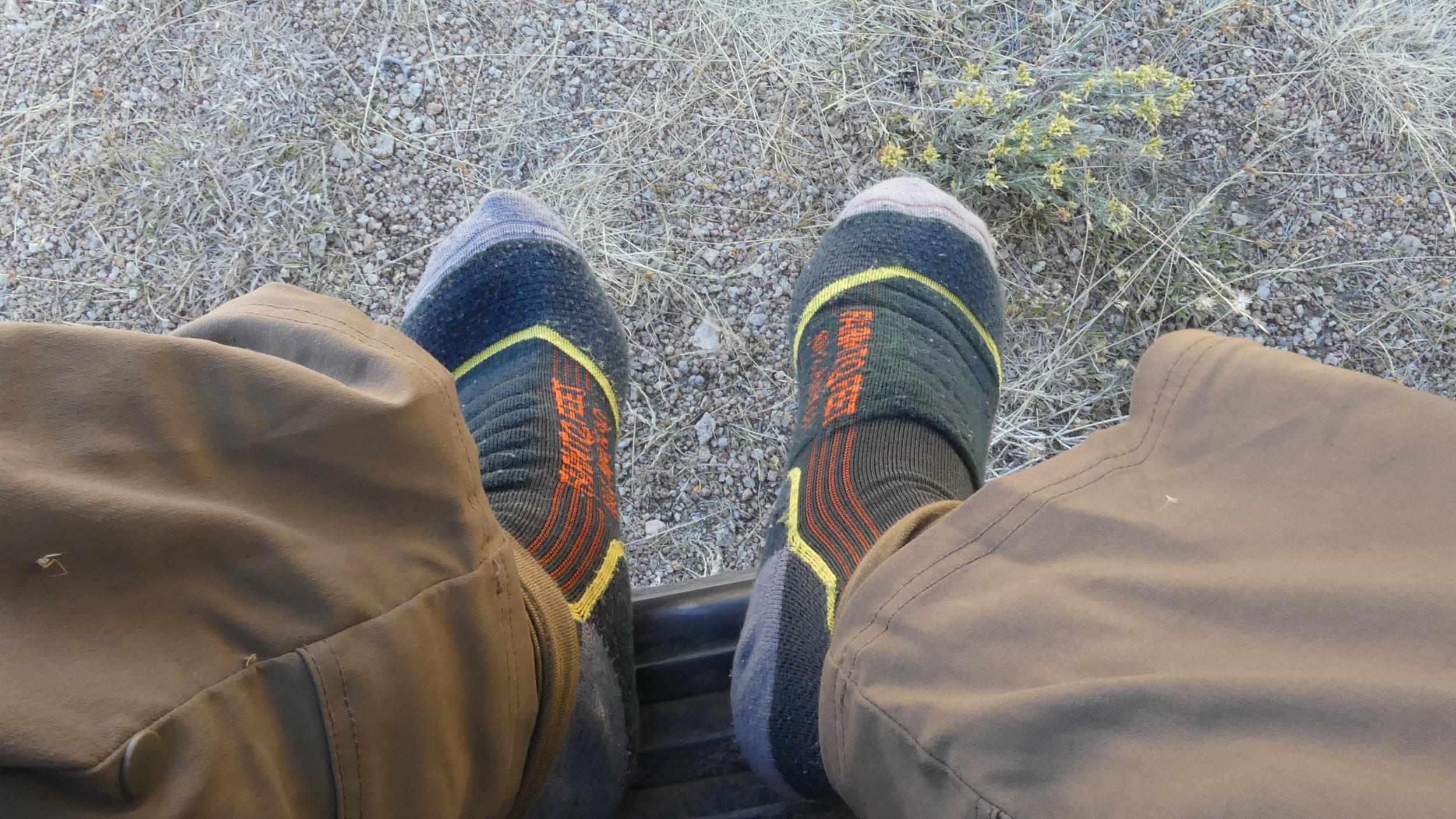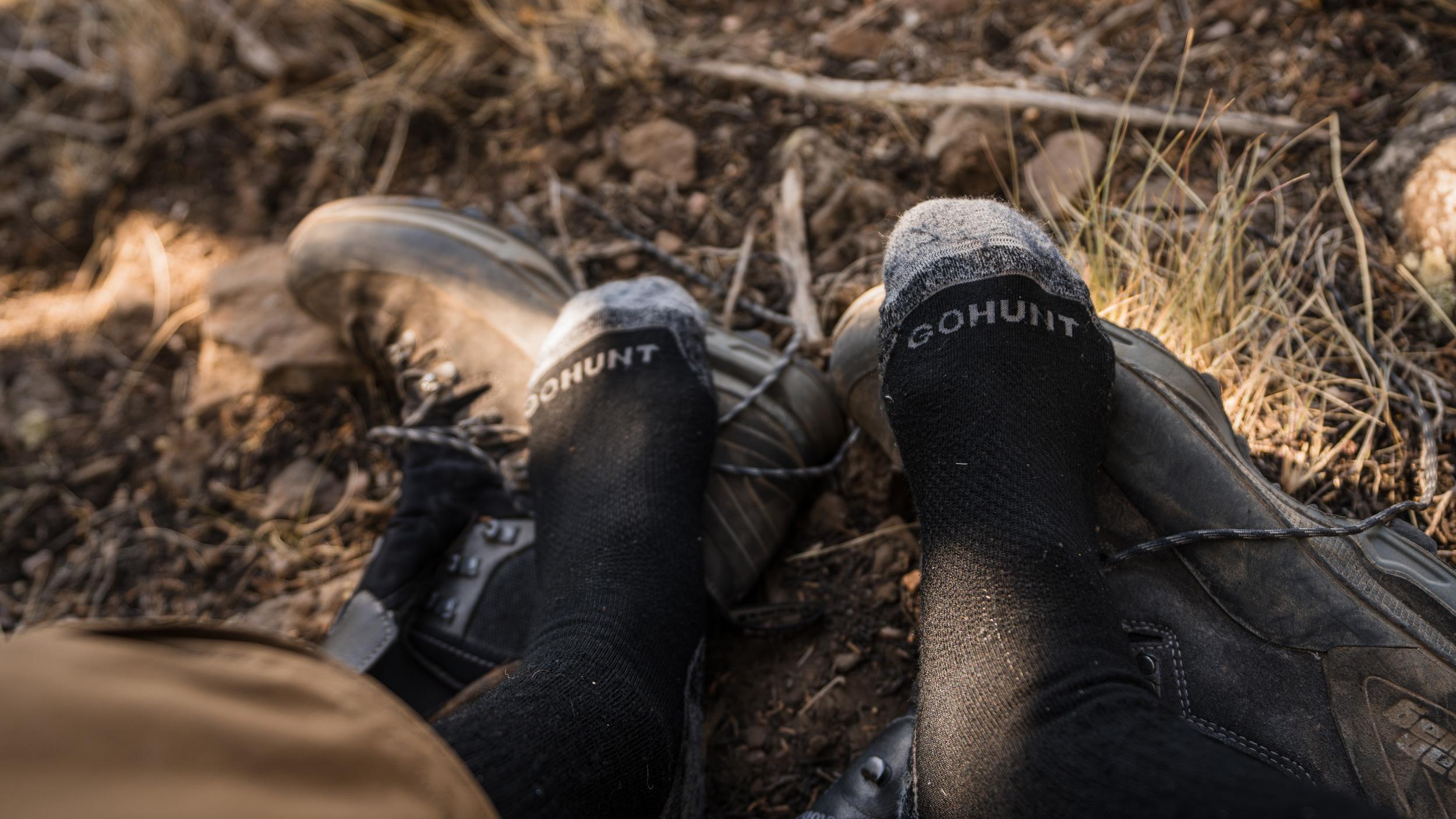




The worst experience on a hike or hunt is a blister from boots or the wrong sock choice.

Farm to Feet Damascus merino wool socks are 100% U.S.-grown merino wool.

GOHUNT Mid-Weight Merino Wool Sock on a mountain hunt.
If you don’t know who I am or what I do for GOHUNT, then let me tell you: I'm one of their resident gear guys. I have the privilege of meeting great people every day in the GOHUNT Showroom with my goal to outfit and educate customers about our gear and Insider tools, and assist them in preparing for their hunts. Two of my focuses — and strong suits — are boots and socks. I love them! Well, not in the way of having a page dedicated to feet, but if you come in for a boot fit, we'll teach you what you should know about good boots and how socks help keep your feet comfortable.
One essential addition to great boots is comfortable, reliable socks. Before heading out on a hunt, it's crucial to consider the socks you are wearing. While socks may not seem like a big deal, their purpose — along with other next-to-skin layers — is to create a comfortable experience, allowing our bodies to breathe and regulate temperature — even in significantly different hunting conditions. If you backpack hunt or hunt during colder seasons, consider your sleep system. Chances are you have put together a comfortable combination of sleeping pad and sleeping bag and maybe even a pillow to maximize rest and comfort so you’re ready for the next day. Footwear is no different.
Sock performance is determined by its ability to wick sweat away from the body and transport it to the surface to dry as well as reduce odor and foot fatigue even after days of use. Socks are a fundamental part of that first layer of clothing — also known as the base layer. You’re probably familiar with cotton socks, which most people wear with dress shoes, casual footwear or to school. That’s great if you don’t exert high levels of energy daily. Other sock blends provide efficient performance, such as a combination of merino wool with synthetic materials like polyester, nylon, or lycra. Additionally, some socks are fully synthetic, like acrylic, polypropylene, and polyester, but still serve the same purpose.
The ideal pair of socks should have quick, moisture-absorbing fibers and be quick-drying to ensure sustained comfort and performance throughout your hunting trip. While boots can also pose challenges, let's focus on socks for now. Our feet can produce about a cup of sweat while hiking or hunting, especially in humid, wet or hot conditions. When combined with high levels of energy exertion, our feet can definitely benefit from wearing the right socks. Merino blended socks have been tested, studied and shown to be more effective in wicking moisture and drying quickly. But let's dive into the details a bit more.
Let’s start with cotton socks. Cotton socks wick sweat away from the body good enough, but that's about all they can do. If you wear cotton socks and clothes while hunting, it's time to stop! Cotton tends to trap moisture against your skin, making the skin soft and causing friction, which can lead to blisters. Moreover, on colder hunts, cotton keeps the body wet as it doesn't dry quickly. That can lead to hypothermia in some extreme cases.
My experience with cotton socks and an improper footwear system began when I was a scientific aid with the California Department of Fish and Wildlife studying desert bighorn sheep in the Mojave desert. Like many desert climates, guess what? It was hot. My boot choice was something lightweight, but wearing some JCPenny Gold Toe “athletic” socks was not a good idea. They lacked the cushion in the high-stress areas like the heel and ball of my foot. The cotton wicked sweat away, but held onto moisture longer during use. On water guzzler, or sheep mortality recovery days, those socks were wet, causing friction, resulting in blisters under my foot and between my toes and on my heels. It’s a tough lesson learned, but switching to a merino wool blended sock has made the difference in keeping me in the field longer and feeling stronger.
Now, let’s look at merino. Merino wool is a little different from wool socks in that merino wool is a thinner diameter fiber and doesn’t itch like regular wool can for some folks. Merino wool has a softer surface fabric. The thinner fiber provides more space between strands, allowing air to travel through the material and increase moisture movement and drying abilities. Merino wool socks are also effective at killing odor because of lanolin — a natural antimicrobial property that dries quickly and reduces the chance for odor-causing bacteria to develop from moisture in your sock fibers.
To get real fun with it, remember that cup of sweat I mentioned earlier? We have a lot of sweat glands and natural bacteria on our feet. Bacteria that feed on dead skin cells and oils. When those bacteria get to work in damp, dark areas, they thrive and a sock is a perfect environment. It’s important to wear socks that can dry quickly, reducing the build-up of bacteria waste, fungus and nasty odors on hunts or hikes.
Pair merino wool with synthetics and you have an incredible product! Remember those synthetic fibers I mentioned earlier? Combining merino wool with synthetic material creates the most efficient sock on this side of the galaxy. Synthetic socks are generally hydrophobic. Meaning they fight off moisture by drying much quicker. Acrylic doesn’t have the insulating properties to keep feet warm and dry, but can get too hot in warmer conditions and can get uncomfortable.
A nifty, specialized polyester fiber called Coolmax is a hybrid-oval-shaped fiber with a larger surface area, moving moisture across a larger surface area, and drying much quicker.
I’ve recently been using and abusing the GOHUNT Mid-Weight Merino Socks this season and the new Darn Tough 2108 Hunting Boot Lightweight Sock with Cushion are nice, too. I’m not a brand guy; I’m a “what’s going to perform the best guy.” My time hunting is precious because I don’t have weeks to hunt. So, maximizing my time in the field scouting and during archery season is thanks to a bulletproof pair of boots and some reliable merino wool blended socks. From late cold archery hunts for deer to hot archery hunts for black bears in California and deer in Nevada, I’m looking to keep my feet happy. Merino wool is a great material to consider in almost any hunt conditions due to its breathability, insulating properties, and antimicrobial DNA.
Choosing the right socks for your next hunt is easy — make them a merino wool blend with synthetics and wear them with your favorite boots. Whether they’re lightweight, midweight or heavyweight cushion socks, once you find the perfect combination in footwear, hunts and outings get easier and more enjoyable. You’ll develop the confidence that keeps you hiking stronger and in the woods longer. You’ll worry less about your feet feeling fatigued and having to cut your hunt short. There are brands like Darn Tough Vermont, GOHUNT, Farm to Feet, Kenetrek and more to choose from, but find your favorite. Let me conclude with this: treat your feet to something sweet. There have been some awesome improvements to hunting gear, so there is no excuse not to upgrade. If you have any questions, please email me or swing by the GOHUNT Showroom, and let’s get you outfitted for your next adventure.